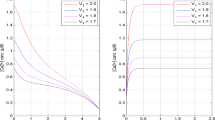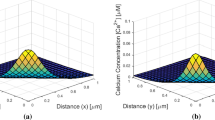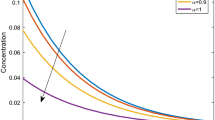Abstract
The models for the dynamics of single systems like calcium ([Ca2+]) in a neuron cell are able to provide information about factors affecting the calcium regulation in the neuron cell. But in realistic conditions, the dynamics of calcium also depends on the dynamics of other chemical molecules like inositol 1, 4, 5-trisphophate (IP3) in the nerve cell. Some research workers explored the interdependent [Ca2+] and IP3 signaling systems in neurons, but that too for integer-order systems only. The studies on integer-order system dynamics are not able to generate insights about the superdiffusion mechanisms, cell memory causing Brownian motion of signaling molecules in neurons. Few attempts to investigate fractional reaction–diffusion models of individual [Ca2+] dynamics have been reported in neurons. However, no attempt is noticed in the literature to analyze the interdependent fractional processes of [Ca2+] and IP3 dynamics in neurons. In the present paper, a mathematical model of nonlinear interdependent spatiotemporal [Ca2+] and IP3 signaling systems is proposed incorporating fractional diffusion processes and cell memory of [Ca2+] and IP3 causing Brownian motion effects in neurons. The numerical solution is obtained by the Crank–Nicolson scheme (CNS) with Grunwald estimation for fractional derivatives along spatial dimensions and L1 scheme for fractional derivatives along temporal dimensions with Gauss–Seidel (GS) iterations. The influences of the superdiffusion mechanism and cell memory on the interdependent [Ca2+] and IP3 signaling systems in neurons are analyzed with the help of numerical results. A significant difference in results is observed between fractional-order and integer-order dynamics. It is concluded that the cell can use memory effects and superdiffusion mechanisms to regulate the calcium and IP3 concentrations at appropriate levels. Further, the fractional-order processes like superdiffusion and cell memory can also be a cause of dysregulation of calcium and IP3 dynamics leading to neurological disorders like Parkinson’s, etc.











Similar content being viewed by others
Data availability
Data sharing is not applicable to this article as no datasets were generated or analyzed during the current study.
References
R. Llinas, Neurosci. Fourth Study Progr. 555 (1979)
N. G. Connor, John A., Calcium Diffus. Buffering Nerve Cytoplasm ISSN 0075 (1982)
H. Rasmussen, P.Q. Barrett, Physiol. Rev. 64, 938 (1984)
J. Sneyd, S. Girard, D. Clapham, 55, (1993)
J. Wagner, J. Keizer, Biophys. J. 67, 447 (1994)
G.D. Smith, J. Wagner, J. Keizer, Biophys. J. 70, 2527 (1996)
S.G. Tewari, K.R. Pardasani, IAENG Int. J. Appl. Math. 40, 1 (2010)
S.G. Tewari, K.R. Pardasani, J. Multiscale Model. 04, 1250010 (2012)
A. Tripathi, N. Adlakha, World Acad. Sci. Eng. Technol. 80, 739 (2011)
A. Jha, N. Adlakha, J. Med. Imaging Heal. Informatics 4, 547 (2014)
B. K. Jha, N. Adlakha, M. N. Mehta, Int. J. Model. Simulation, Sci. Comput. 4, (2013)
B.K. Jha, N. Adlakha, M.N. Mehta, Int. J. Biomath. 7, 1 (2014)
N. Manhas, J. Sneyd, K.R. Pardasani, J. Biosci. 39, 463 (2014)
N. Manhas, K.R. Pardasani, J. Bioenerg. Biomembr. 46, 403 (2014)
K. Pathak, N. Adlakha, Alexandria. J. Med. 52, 261 (2016)
K.B. Pathak, N. Adlakha, J. Med. Imaging Heal. Informatics 5, 683 (2015)
S. Panday, K.R. Pardasani, J. Med. Imaging Heal. Informatics 3, 374 (2013)
P.A. Naik, K.R. Pardasani, Int. J. Comput. Methods 16, 1 (2019)
P.A. Naik, K.R. Pardasani, Alexandria. J. Med. 52, 43 (2016)
P.A. Naik, K.R. Pardasani, J. Med. Imaging Heal. Informatics 5, 471 (2015)
M. Kotwani, N. Adlakha, M.N. Mehta, Appl. Math. Sci. 6, 5063 (2012)
M. Kotwani, N. Adlakha, M.N. Mehta, J. Med. Imaging Heal. Informatics 4, 840 (2014)
A.B. Kothiya, N. Adlakha, J. Biol. Phys. 49, 133 (2023)
Y. Jagtap, N. Adlakha, Commun. Math. Biol. Neurosci. 2018, 1 (2018)
V. Mishra, N. Adlakha, J. Biol. Phys. (2023)
V. Mishra, N. Adlakha, J. Bioenerg. Biomembr. (2023)
H. Bhardwaj, N. Adlakha, Int. J. Comput. Methods (2022)
H. Bhardwaj and N. Adlakha, J. Mech. Med. Biol. (2023).
Vaishali, N. Adlakha, J. Bioenerg. Biomembr. (2023)
F. Sala, A. Hernández-Cruz, Biophys. J. 57, 313 (1990)
A. Tripathi, N. Adlakha, Appl. Math. Sci. 6, 455 (2012)
M.J. Berridge, R.F. Irvine, Nature 312, 315 (1984)
M.J. Berridge, Nature 361, 315 (1993)
J. Wagner, C.F. Fall, F. Hong, C.E. Sims, N.L. Allbritton, R.A. Fontanilla, I.I. Moraru, L.M. Loew, R. Nuccitelli, Cell Calcium 35, 433 (2004)
M. Falcke, R. Huerta, M.I. Rabinovich, H.D.I. Abarbanel, R.C. Elson, A.I. Selverston, Biol. Cybern. 82, 517 (2000)
J.N. Teramae, T. Fukai, J. Comput. Neurosci. 18, 105 (2005)
T. Furuichi, K. Mikoshiba, J Neuroquem 63 (1995)
G.W.D.E. Young, J. Keizer, Biophysics (Oxf). 89, 9895 (1992)
Y.X. Li, J. Rinzel, J. Theor. Biol. 166, 461 (1994)
N. Singh and N. Adlakha, Netw. Model. Anal. Heal. Informatics Bioinforma. 8, (2019).
N. Singh, N. Adlakha, Math. Biol. Bioinforma. 14, 290 (2019)
Y. Jagtap, N. Adlakha, Eur. Phys. J. Plus 138, 1 (2023)
A. Pawar, K.R. Pardasani, Eur. Phys. J. Plus 137, 543 (2022)
A. Pawar, K.R. Pardasani, Cogn. Neurodyn. 2022, 1 (2022)
A. Pawar, K. R. Pardasani, Eur. Biophys. J. (2023)
A. Pawar, K. R. Pardasani, Eur. Phys. J. Plus 2022 1378 137, 1 (2022)
A. Pawar and K. R. Pardasani, Cogn. Neurodyn. 1 (2022).
A. Pawar, K.R. Pardasani, Eur. Phys. J. Plus 123, 1 (2023)
P.A. Naik, M. Yavuz, S. Qureshi, J. Zu, S. Townley, Eur. Phys. J. Plus 135, 1 (2020)
A. Pawar, K. R. Pardasani, Phys. Scr. 98, (2023)
R.L. Magin, J.R. Bourne, 32, (2004)
F. Mainardi, Fractional Calculus: Some Basic Problems in Continuum and Statistical Mechanics (2012)
M.M. Meerschaert, C. Tadjeran, J. Comput. Appl. Math. 172, 65 (2004)
R.L. Magin, Comput. Math. with Appl. 59, 1586 (2010)
I. Podlubny, A. Chechkin, T. Skovranek, Y. Q. Chen, B. M. Vinagre Jara, J. Comput. Phys. 228, 3137 (2009)
L.C. Cardoso, F.L.P. Dos Santos, R.F. Camargo, Comput. Appl. Math. 37, 4570 (2018)
M. Du, Z. Wang, H. Hu, Sci. Rep. 3, (2013)
H. Joshi, B. K. Jha, Eur. Phys. J. Plus 136, (2021)
H. Joshi, B.K. Jha, Comput. Appl. Math. 39, 1 (2020)
M.A. Ezzat, A.S.E. Karamany, Zeitschrift Fur Angew. Math. Und Phys. 62, 937 (2011)
E. Sousa, J. Comput. Phys. 228, 4038 (2009)
A. S. Chaves, Phys. Lett. Sect. A Gen. At. Solid State Phys. 239, 13 (1998)
C.E. Sims, N.L. Allbrittont, J. Biol. Chem. 273, 4052 (1998)
A. Bugrim, R. Fontanilla, B.B. Eutenier, J. Keizer, R. Nuccitelli, Biophys. J. 84, 1580 (2003)
G.D. Smith, Biophys. J. 71, 3064 (1996)
S.A. Brown, F. Morgan, J. Watras, L.M. Loew, Biophys. J. 95, 1795 (2008)
B.K. Jha, H. Joshi, D.D. Dave, Interdiscip. Sci. Comput. Life Sci. 10, 674 (2018)
M. Brini, T. Calì, D. Ottolini, E. Carafoli, Cell. Mol. Life Sci. 71, 2787 (2014)
C. Tadjeran, M.M. Meerschaert, H.P. Scheffler, J. Comput. Phys. 213, 205 (2006)
K. Oldham,J. Spanier, The Fractional Calculus Theory and Applications of Differentiation and Integration to Arbitrary Order (Academic Press, INC. (London) LTD., 1974)
Author information
Authors and Affiliations
Contributions
Concerning problem formulation, literature review, solution, and interpretation of findings, both authors equitably contributed to this research. Author (1) develops the MATLAB program.
Corresponding author
Appendix: Model equations summary
Appendix: Model equations summary
For the solution of Eqs. (1) and (7), the CNS with Grunwald approximation to the fractional derivatives along space is expressed as [69]:
Here, C = [Ca2+] and P = IP3 and h represents step size along space, for i = 1, 2, 3, …, K-1. The normalized Grunwald weights g1k and g2k, which are dependent on the index k and order V1 and V2, sequentially can be represented as shown below:
For Eqs. (1) and (7), the expressions for the fractional time derivative by the L1 formula are proposed by Oldham and Spanier [70] and shown as below:
where
For solving the acquired fractional-order equations, the CNS with Grunwald estimation along space derivative and the L1 formula along time derivative are utilized.
Utilizing Eqs. (18 & 22) in Eq. (1), we have
Utilizing the Eqs. (19 and 23) in Eq. (7), we obtain
From Eq. (26), we obtain,
Defining, \({{B1 = D}}_{{{\text{Ca}}}} \frac{{{{\Gamma (2 - U}}_{{1}} {{)(\Delta t)}}^{{{\text{U}}_{{1}} }} }}{{{{2h}}^{{{\text{V}}_{{1}} }} }}\), then Eq. (29) can be written as follows:
where \({{d1(C}}_{{\text{i}}}^{{\text{j}}} {{,P}}_{{\text{i}}}^{{\text{j}}} {)}\) depicts the nonlinear terms for Eq. (26).
Equation (32) expresses the nonlinear equations system, which is rewritten as,
where
The coefficients matrix is expressed by \({{\overline{A}1 = [A1}}_{{\text{i,j}}} {] }\) for i, j = 1, 2, …, K-1 as,
Similarly, utilizing the L1 scheme along temporal dimensions and the CNS with Grunwald estimation along spatial dimensions for Eq. (27), we obtain the nonlinear equations system as,
where \({{d2(C}}_{{\text{i}}}^{{\text{j}}} {{,P}}_{{\text{i}}}^{{\text{j}}} {)}\) depicts the nonlinear terms of Eq. (27), where
The coefficients matrix is expressed by \({{\overline{A}2 = [A2}}_{{\text{i,j}}} {] }\) for i, j = 1, 2, 3, …, K-1 as follows:
where\({{B2 = D}}_{{\text{i}}} \frac{{{{\Gamma (2 - U}}_{2} {{)(\Delta t)}}^{{{\text{U}}_{2} }} }}{{{{2h}}^{{{\text{V}}_{2} }} }}\).
Let λ1 is an eigenvalue of matrix A1, such that A1X = λ1X for some non-zero vector X. Consider \(\left| {{{x}}_{{\text{i}}} } \right|{{ = max}}\left\{ {\left| {{{x}}_{{\text{j}}} } \right|:{{ j = 0, 1, 2, }}...{{, K}}} \right\}\), then \(\sum\nolimits_{{\text{j = 0}}}^{{\text{K}}} {{{A1}}_{{\text{i,j}}} } {{ x}}_{{\text{j}}} {{ = \lambda }}_{{1}} {{x}}_{{\text{i}}}\), this implies
Putting the Ai,j values in Eq. (43), we obtain
Since \(\left( {\sum\nolimits_{{{K = 0}}}^{\infty } {{{g1}}_{{\text{K}}} } = 0} \right)\) and g11 is the only expression in Grunwald weights sequence that is negative, and \({{g1}}_{{1}} { = } - {{V}}_{{1}}\) and thus for \({{1 < V}}_{{1}} \le {2 }\)
Since \(\left| {\frac{{{{x}}_{{\text{j}}} }}{{{{x}}_{{\text{i}}} }}} \right| \le 1{{ and g1}}_{{\text{j}}} \ge 0,{{ for j = 0, 2, 3, }}...{, }\)
Similarly, for the matrix A2,
For interdependent [Ca2+] and IP3 signaling systems, we get the matrix representation as follows:
Because, B1 and B2 are non-negative real numbers, all the eigenvalues of A1, A2 and A fulfill the condition \(\left| {\uplambda } \right| \ge 1\). Then, matrix A is invertible, and each eigenvalue of A−1 satisfies \(\left| {\upeta } \right| \le 1\). Therefore, the spectral radius of matrix is \({{\rho (A}}^{{ - 1}} {)} \le 1\) and suggests that the employed scheme is unconditionally stable.
Rights and permissions
Springer Nature or its licensor (e.g. a society or other partner) holds exclusive rights to this article under a publishing agreement with the author(s) or other rightsholder(s); author self-archiving of the accepted manuscript version of this article is solely governed by the terms of such publishing agreement and applicable law.
About this article
Cite this article
Pawar, A., Pardasani, K.R. Fractional-order reaction–diffusion model to study the dysregulatory impacts of superdiffusion and memory on neuronal calcium and IP3 dynamics. Eur. Phys. J. Plus 138, 780 (2023). https://doi.org/10.1140/epjp/s13360-023-04410-6
Received:
Accepted:
Published:
DOI: https://doi.org/10.1140/epjp/s13360-023-04410-6




